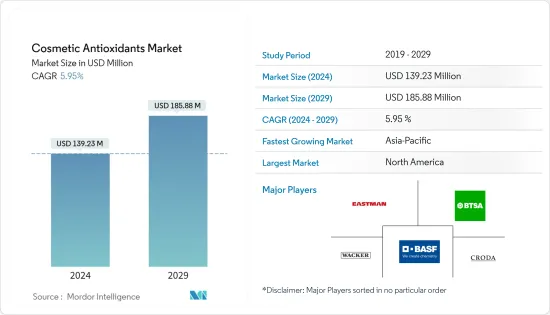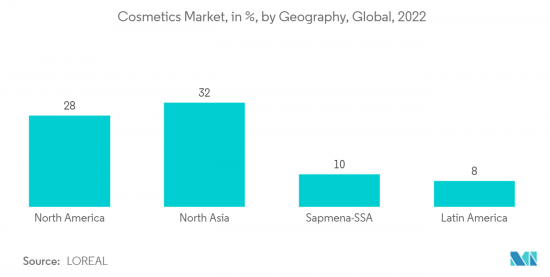
|
市場調査レポート
商品コード
1407947
化粧品用酸化防止剤:市場シェア分析、産業動向と統計、2024~2029年の成長予測Cosmetic Antioxidants - Market Share Analysis, Industry Trends & Statistics, Growth Forecasts 2024 - 2029 |
||||||
カスタマイズ可能
適宜更新あり
|
|||||||
| 化粧品用酸化防止剤:市場シェア分析、産業動向と統計、2024~2029年の成長予測 |
|
出版日: 2024年01月04日
発行: Mordor Intelligence
ページ情報: 英文 120 Pages
納期: 2~3営業日
|
- 全表示
- 概要
- 目次
化粧品用酸化防止剤の市場規模は2024年に1億3,923万米ドルと推定され、2029年には1億8,588万米ドルに達すると予測され、予測期間(2024-2029年)のCAGRは5.95%で成長する見込みです。

市場は2020年のCOVID-19によってマイナスの影響を受け、パンデミックによってオンライン・オフラインチャネルを通じた化粧品の生産と販売の両方が中断されました。しかし、世界情勢は正常化しつつあり、業界が安定に戻りつつあることは、業界の業績を向上させる複数の成長機会を提供しています。
ポリフェノール、カロテノイド、酵素、合成、ビタミンC、ビタミンEなどの天然抗酸化物質がオンラインで容易に入手できるようになり、市場の需要を牽引しています。
天然抗酸化物質のコストが高いこと、合成抗酸化物質の使用に対する懸念が高まっていることが、化粧品用酸化防止剤市場の主な抑制要因として指摘されています。
化粧品における天然由来の酸化防止剤に対する需要の高まりの結果、世界の消費者は天然スキンケア製品に傾倒しており、これは調査期間中に市場に機会を生み出しています。
アジア太平洋地域は、インドや中国などの国々から様々な酸化防止剤を含む化粧品が最も多く消費され、市場を独占すると予想されます。
化粧品用酸化防止剤市場の動向
化粧品における天然酸化防止剤の使用の増加
- 化粧品業界では、ポリフェノール、カロテノイド、酵素、合成ビタミンC、ビタミンEなどの天然抗酸化物質が様々なアンチエイジングクリームに使用されるようになってきており、スキンケア化粧品における天然酸化防止剤の使用が増加すると予想されています。
- 植物エキスに含まれる天然の酸化防止剤には、ポリフェノール、フラボノイド、フラボノール、フラバノール、スチルベン、テルペン(カロテノイドやエッセンシャルオイルを含む)などがあります。
- 米国のバイオテクノロジー企業であるデバットは、ロレアルのコーポレート・ベンチャー・キャピタル・ファンドであるボールドが主導する資金調達ラウンドであるシリーズBで、3,400万米ドルを調達しました。この資金調達ラウンドでは、デバットの広範なIPポートフォリオを活用し、7,000以上の原材料から、ポリフェノール、バイオポリマー、天然色素など、高性能、老化防止、抗酸化作用で珍重される複合天然製品を製造します。
- 現在、女性の間では早期老化が大きな関心事となっています。美容ケア製品における酸化防止剤の使用は、今後増加すると推定されます。抗シワクリームや保湿剤は現在、広く普及しつつあります。
- 2023年1月、マックコスメティックスはインド市場で新しいスキンケアラインを発売する計画を発表しました。北米の美容ブランドによるこの動きは、インドにおけるスキンケア製品の重要性の高まりを浮き彫りにしています。化粧品用酸化防止剤メーカーにとっては、拡大するこのセグメントの需要に応える好機となります。
- 美容と健康に関する世界のオンラインeコマース・プラットフォームであるNykaaによると、インドは今後5年以内に欧州諸国を抜き、世界第5位の化粧品市場になる勢いだといいます。
- さらに、ポリフェノールなどの天然抗酸化物質が皮膚の治癒や若返りに役立つという知識も広がっています。化粧品用酸化防止剤の世界市場を押し上げると予想される要因には、シミ、小ジワ、シミなどの老化現象を回復させる作用があり、アンチエイジング治療の定番となっていることなどがあります。
- これらの要因により、化粧品用酸化防止剤市場は予測期間中に世界的に成長する可能性が高いです。

アジア太平洋地域が市場を独占する
- アジア太平洋地域は、2023年に収益面で大きな市場シェアを獲得して世界市場を独占し、予測期間中もその優位性を維持すると予測されます。
- 中国、インド、韓国は、予測期間中、化粧品用酸化防止剤消費の旺盛な需要を目の当たりにする主要国になると予想されます。
- 汚染や気候変動の影響から肌や髪を守る高品質な化粧品の使用が増加していることが、酸化防止剤の需要を押し上げ、化粧品用酸化防止剤市場に拍車をかけています。
- 中国は世界で最も急成長している、最もダイナミックな市場です。いくつかの化粧品会社は、インフルエンサーや美容ブロガーと協力し、製品の売上を伸ばすためにテレビで広告を出しています。中国の地元ブランドは消費者に低価格から中価格の化粧品を提供しているが、外資系企業はハイエンド・セグメントに対応しています。それにもかかわらず、売上を伸ばすために、国内メーカーは化粧品に自然抽出法を利用し始めています。
- Voguebusinessによると、多種多様なスキンケア、メイクアップ、ヘア製品を含むインドの美容産業は、2018年の123億米ドルから2022年には156億米ドルに成長し、2025年には約174億米ドルになると推定されています。
- しかし、国際的なブランドはインドの肌タイプに適した製品の需要を満たすことができず、Mama Earth、Khadi Essential、Sugar Cosmeticsなどの地元企業が自家製化粧品やパーソナルケア製品を普及させることができました。
- 韓国は世界で最もダイナミックな美容市場のひとつであり、業界をリードするイノベーションを導入し、世界の動向をリードしています。成功するために、韓国のスキンケアと化粧品業界は規模が大きく、細分化され、競争が激しく、各ブランドは常に新製品を研究開発しています。
- このような要因から、同地域の化粧品用酸化防止剤市場は予測期間中に安定した成長が見込まれます。
化粧品用酸化防止剤産業の概要
化粧品用酸化防止剤市場は部分的に細分化されています。主なプレーヤー(順不同)としては、BASF SE、Eastman Chemical Company、Wacker Chemie AG、Croda International Plc、BTSA Biotecnologias Aplicadasなどが挙げられます。
その他の特典:
- エクセル形式の市場予測(ME)シート
- 3ヶ月間のアナリスト・サポート
目次
第1章 イントロダクション
- 調査の前提条件
- 調査範囲
第2章 調査手法
第3章 エグゼクティブサマリー
第4章 市場力学
- 促進要因
- 化粧品のオンライン購入の増加
- 美容製品とパーソナルケア製品の使用の増加
- その他の促進要因
- 抑制要因
- 天然抗酸化物質のコスト高
- その他の抑制要因
- 産業バリューチェーン分析
- ポーターのファイブフォース分析
- 供給企業の交渉力
- 買い手の交渉力
- 新規参入業者の脅威
- 代替品の脅威
- 競合の程度
第5章 市場セグメンテーション(金額ベース市場規模)
- 由来
- 天然
- 化学由来
- タイプ
- ビタミン
- ポリフェノール
- 酵素
- カロテノイド
- その他のタイプ(フラボノイド、ビタミン、合成、テルペン類)
- 用途
- スキンケア
- ヘアケア
- 注射剤
- その他の用途(メイクアップ、ボディケア)
- 地域
- アジア太平洋
- 中国
- インド
- 日本
- 韓国
- その他アジア太平洋地域
- 北米
- 米国
- カナダ
- メキシコ
- 欧州
- ドイツ
- 英国
- イタリア
- フランス
- その他欧州
- 南米
- ブラジル
- アルゼンチン
- その他南米
- 中東・アフリカ
- サウジアラビア
- 南アフリカ
- その他中東とアフリカ
- アジア太平洋
第6章 競合情勢
- M&A、合弁事業、提携、協定
- 市場シェア(%)**/ランキング分析
- 主要企業の戦略
- 企業プロファイル
- BASF SE
- BTSA Biotecnologias Aplicadas
- Croda International Plc
- Eastman Chemical Company
- Evonik Industries AG
- Kemin Industries
- Koninklijke DSM
- Lonza Group
- Provital Group
- Wacker Chemie AG
第7章 市場機会と今後の動向
- 男性化粧品に対する需要の高まり
- その他の市場機会と今後の動向

The Cosmetic Antioxidants Market size is estimated at USD 139.23 million in 2024, and is expected to reach USD 185.88 million by 2029, growing at a CAGR of 5.95% during the forecast period (2024-2029).
The market was negatively impacted by COVID-19 in 2020, the pandemic disrupted both production and sales of cosmetics through online and offline channels. However, the global situation is normalizing, and the industry's return to stability provides multiple growth opportunities for improving the industry's performance.
Readily availability of natural antioxidants online, such as such as polyphenols, carotenoids, enzymes, synthetic, vitamin C, and vitamin E, driving the market demand.
The high cost of natural antioxidants and growing concerns about the use of synthetic antioxidants have been identified as major restraints in the cosmetic antioxidant market.
Consumers worldwide are leaning toward natural skin care products as a result of the rising demand for naturally derived antioxidants in cosmetics, which is creating an opportunity for the market during the study period.
Asia-Pacific region is expected to dominate the market with the largest consumption of cosmetics containing various antioxidants from countries such as India and China.
Cosmetic Antioxidants Market Trends
Increasing Usage of Natural Antioxidants in Cosmetics Products
- The growing use of natural antioxidants such as polyphenols, carotenoids, enzymes, synthetic vitamin C, and vitamin E is being increasingly used in the cosmetic industry in various anti-aging creams, which is expected to increase the use of natural oxidants in skin care cosmetic products.
- Natural antioxidants present in plant extracts include polyphenols, flavonoids, flavonols, flavanols, stilbenes, and terpenes (including carotenoids and essential oils).
- US biotech company Debut has raised USD 34 million in Series B, a funding round led by Bold, L'Oreal's corporate venture capital fund that leverages the start-up's extensive IP portfolio, from which more than 7,000 ingredients to produce complex natural products, such as polyphenols, biopolymers, and natural colors, prized for their high performance, anti-aging, and antioxidant properties.
- Nowadays, premature aging is a major concern among women. The use of antioxidants in beauty care products is estimated to grow. Anti-wrinkle creams and moisturizers are now becoming widely popular.
- In January 2023, Mac Cosmetics announced its plans to launch a new skincare line in the Indian market. This move by the North American beauty brand highlights the growing importance of skincare products in India. It presents an opportunity for Cosmetic antioxidant manufacturers to meet the demands of this expanding segment.
- According to Nykaa, a global online beauty and wellness e-commerce platform, India is on track to overtake several European countries and become the fifth-largest cosmetics market in the world within the next five years.
- Furthermore, there is a growing knowledge of the benefits of natural antioxidants such as polyphenols, which can be helpful for skin healing and rejuvenation. Some of the factors that are expected to boost the global cosmetic antioxidant market include their ability to help reverse indications of aging, such as sunspots, fine lines, and wrinkles, making them a staple in anti-aging treatments.
- Owing to all these factors, the market for Cosmetic Antioxidants is likely to grow globally during the forecast period.

Asia-Pacific Region to Dominate the Market
- The Asia-Pacific region dominated the worldwide market in 2023, with a significant market share in terms of revenue, and is projected to maintain its dominance during the forecast period.
- China, India, and South Korea are expected to be leading countries witnessing strong demand for cosmetic antioxidant consumption during the forecast period.
- The increasing use of high-quality cosmetic products that prevent the skin and hair from the effects of pollution and climate change is driving up demand for antioxidants, fueling the cosmetic antioxidants market.
- China is the world's fastest-growing and most dynamic market. Several cosmetics companies have collaborated with influencers, beauty bloggers, and advertising on TV to increase product sales. Local brands in China provide consumers with low-to-mid-priced cosmetic products, whereas foreign players cater to the high-end segment. Nonetheless, to increase sales, domestic players have started to utilize natural extraction methods in their cosmetic products.
- According to Voguebusiness, the Indian beauty industry, which includes a wide variety of skincare, makeup, and hair products, has grown from USD 12.3 billion in 2018 to USD 15.6 billion in 2022, and it is estimated to be worth around USD 17.4 billion in 2025.
- However, international brands were unable to meet the demand for products suitable for Indian skin types, allowing local companies such as Mama Earth, Khadi Essential, and Sugar Cosmetics to promote their homemade cosmetics and personal care products.
- South Korea has one of the world's most dynamic beauty markets, introducing industry-leading innovations and setting global trends. In order to succeed, the Korean skincare and cosmetics industry is large, fragmented, and highly competitive, with brands constantly researching and developing new products.
- Due to all such factors, the market for cosmetic antioxidants in the region is expected to have a steady growth during the forecast period.
Cosmetic Antioxidants Industry Overview
The cosmetic antioxidants market is partially fragmented in nature. The major players (not in any particular order) include BASF SE, Eastman Chemical Company, Wacker Chemie AG., Croda International Plc, and BTSA Biotecnologias Aplicadas, among others.
Additional Benefits:
- The market estimate (ME) sheet in Excel format
- 3 months of analyst support
TABLE OF CONTENTS
1 INTRODUCTION
- 1.1 Study Assumptions
- 1.2 Scope of the Study
2 RESEARCH METHODOLOGY
3 EXECUTIVE SUMMARY
4 MARKET DYNAMICS
- 4.1 Drivers
- 4.1.1 Rise in Online Purcahse of Cosmetics
- 4.1.2 Increasing Use of Beauty Products and Personal Care Products
- 4.1.3 Other Drivers
- 4.2 Restraints
- 4.2.1 High Cost of Natural Antioxidants
- 4.2.2 Other Restraints
- 4.3 Industry Value Chain Analysis
- 4.4 Porter's Five Forces Analysis
- 4.4.1 Bargaining Power of Suppliers
- 4.4.2 Bargaining Power of Buyers
- 4.4.3 Threat of New Entrants
- 4.4.4 Threat of Substitute Products and Services
- 4.4.5 Degree of Competition
5 MARKET SEGMENTATION (Market Size in Value)
- 5.1 Source
- 5.1.1 Natural
- 5.1.2 Chemically Derived
- 5.2 Type
- 5.2.1 Vitamins
- 5.2.2 Polyphenols
- 5.2.3 Enzymes
- 5.2.4 Carotenoids
- 5.2.5 Other Types ( Flavonoids, Vitamins, Synthetic and Terpenes)
- 5.3 Application
- 5.3.1 Skin Care
- 5.3.2 Hair Care
- 5.3.3 Injectables
- 5.3.4 Other Applications (Makeup and Body care)
- 5.4 Geography
- 5.4.1 Asia-Pacific
- 5.4.1.1 China
- 5.4.1.2 India
- 5.4.1.3 Japan
- 5.4.1.4 South Korea
- 5.4.1.5 Rest of Asia-Pacific
- 5.4.2 North America
- 5.4.2.1 United States
- 5.4.2.2 Canada
- 5.4.2.3 Mexico
- 5.4.3 Europe
- 5.4.3.1 Germany
- 5.4.3.2 United Kingdom
- 5.4.3.3 Italy
- 5.4.3.4 France
- 5.4.3.5 Rest of Europe
- 5.4.4 South America
- 5.4.4.1 Brazil
- 5.4.4.2 Argentina
- 5.4.4.3 Rest of South America
- 5.4.5 Middle-East and Africa
- 5.4.5.1 Saudi Arabia
- 5.4.5.2 South Africa
- 5.4.5.3 Rest of Middle-East and Africa
- 5.4.1 Asia-Pacific
6 COMPETITIVE LANDSCAPE
- 6.1 Mergers and Acquisitions, Joint Ventures, Collaborations, and Agreements
- 6.2 Market Share (%)**/Ranking Analysis
- 6.3 Strategies Adopted by Leading Players
- 6.4 Company Profiles
- 6.4.1 BASF SE
- 6.4.2 BTSA Biotecnologias Aplicadas
- 6.4.3 Croda International Plc
- 6.4.4 Eastman Chemical Company
- 6.4.5 Evonik Industries AG
- 6.4.6 Kemin Industries
- 6.4.7 Koninklijke DSM
- 6.4.8 Lonza Group
- 6.4.9 Provital Group
- 6.4.10 Wacker Chemie AG
7 MARKET OPPORTUNITIES AND FUTURE TRENDS
- 7.1 Rising Demand for Male Cosmetics Products
- 7.2 Other Market Opportunities And Future Trends


